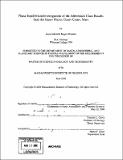Phase equilibrium investigations of the Adirondack Class basalts from the Gusev plains, Gusev crater, Mars
Author(s)
Monders, Anna Gabrielle Bogan
DownloadFull printable version (2.115Mb)
Other Contributors
Massachusetts Institute of Technology. Dept. of Earth, Atmospheric, and Planetary Sciences.
Advisor
Timothy L. Grove.
Terms of use
Metadata
Show full item recordAbstract
Phase equilibrium experiments have been performed on a synthetic analog of the Gusev plains basalt composition from the Spirit landing site on Mars, determined by the Alpha Particle X-ray Spectrometer on the Spirit Rover (Gellert et al., 2006; McSween et al., 2006). The near-liquidus phase relations were determined over the pressure range of 0.1 MPa to 1.5 GPa and at temperatures from 1105 °C to 1390 °C in a piston cylinder apparatus and l-atm gas mixing furnace. The composition is multiply saturated with olivine, orthopyroxene, and spinel on the liquidus at 1310 °C and 1.0 GPa, or 85 km depth on Mars, placing an upper limit constraint on the thickness of the Martian lithosphere at the time of eruption. Experiments carried out at 0.1 MPa show Fo77 olivine as the first liquidus silicate mineral, appearing near 1250 °C. Olivine and spinel co-crystallize until pigeonite and plagioclase (An73) join the crystallizing assemblage at 1125 °C. Low pressure crystallization of the Gusev composition does not produce liquids that could be parental magmas to surface types 1 and 2 of the Martian surface, nor do they appear to be related to olivine-phyric shergottites or other SNC meteorites. The iron-rich Gusev basalts appear to have been crystallized from a less depleted mantle source than the magnesian olivine-phyric shergottite Yamoto 980459.
Description
Thesis (S.M.)--Massachusetts Institute of Technology, Dept. of Earth, Atmospheric, and Planetary Sciences, 2006. Includes bibliographical references (leaves 48-51).
Date issued
2006Department
Massachusetts Institute of Technology. Department of Earth, Atmospheric, and Planetary SciencesPublisher
Massachusetts Institute of Technology
Keywords
Earth, Atmospheric, and Planetary Sciences.